by Winding Pathways | Mar 21, 2024 | Garden/Yard, Garden/Yard, Trees
Bright! Beautiful! Ominous!
As we walked across a New Jersey parking lot last summer an amazingly colorful, and new-to-us, insect fluttered in front of us. It had a gorgeous creamy white and bright red body covered with black spots.
Identifying it was easy and ominous. It was a Spotted Lanternfly. First found in Pennsylvania in 2014 it likely came to the United States from its native China as a hitchhiker in a crate or box.
It may be a pretty bug but its presence is ominous. It feeds on at least 172 different plant species and is spreading rapidly westward from its start close to the Atlantic Ocean.
Feeding off Another Invasive
What’s somewhat ironic about the lanternfly is the insect’s affinity for another Chinese invasive, the Tree of Heaven or Ailanthus. Although the inch-long insect will eat many different plants it prefers this highly aggressive and fast-growing tree.
Important Contact Information
The Iowa Department of Agriculture and Land Stewardship is on the lookout for the Spotted Lanternfly. They ask anyone spotting one in Iowa to report it by calling:
l (515)725-1470 or logging onto their website at IowaAgriculture.gov.
How To Reduce the Invasion
A key to reducing this insect’s abundance may be reducing Ailanthus tree numbers. This invasive tree thrives in urban and rural areas, often forming large groves. It displaces native trees, has little commercial value, and now harbors an introduced insect pest.
Winding Pathways encourages anyone with an Ailanthus in their yard to remove it, convert it to firewood if you can, and replace it with a native tree species. Remember, report any Spotted Lanternflies you spot.
-
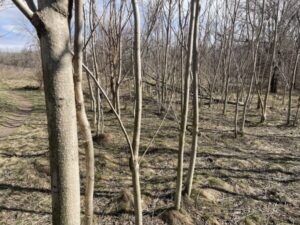
-
Grove of young Ailanthus.
-
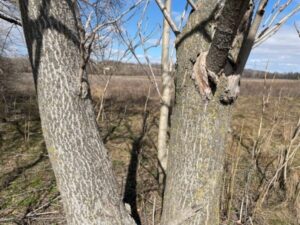
-
Ailanthus trees grow fast.
by Winding Pathways | Nov 30, 2023 | (Sub)Urban Homesteading, Garden/Yard
On Fire?
Many readers know we burn our yard. What? Are we nuts? Fire kills. Fire destroys. Well, it can but it also cleanses and heals.
It’s one way to manage natural growth on properties. So, on a balmy early November day, we set our yard on fire! Flames towered over the yard as intense heat pushed outward.
We usually burn smallish prairies we’ve planted in both our front and back yards. Years ago, we usually burned in March but more recently we’ve shifted to November. Burning in fall seems to encourage wildflower blooms next summer.
Preparation is the Key
We’re unusual but not reckless. (A good read is at this address. www.prairienursery.com/media/pdf/burn-your-prairie-safely.pdf.) Before burning we did these things:
- Mowed a wide firebreak around our proposed burn area. Closely clipped lawns are nearly as effective as a firebreak as pavement or bare soil.
- Acquired a fire permit from Linn County Public Health.
- Found friends and neighbors to help us manage the burn.
- Ahead of time educated neighbors about the value of burning and then alerted them of our plan to burn in a certain time frame.
- Had appropriate tools on hand before we burned. These included garden rakes, matches, and both a portable fire pump, called a “Smith Indian”, and a hose stretched to the burn site.
-
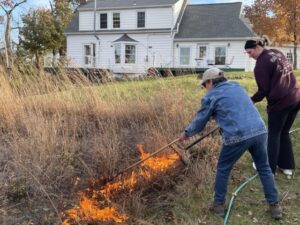
-
Workers spread flames.
-

-
Working together.
Important Last-Minute Steps
On the day of our proposed burn, we did what the Health Department requires and first checked the air pollution report. We are only allowed to burn when the air quality is good, so jump online to a local map that shows real-time air quality. If the air quality is good, we call the sheriff’s department before burning. This is so that if someone reports smoke or fire, they know not to send out firefighters.
A light breeze helps push the fire through standing dried-out prairie grass, but too much wind can be dangerous. Our permit allows us to burn only if the wind is 20 mph or less.
Consideration of Neighbors
Because busy 30th Street Drive is our south property border we burn only when a south wind will push smoke away from the road and neighbor’s homes. North of our property is a large woodland where no one lives and there’s plenty of space for the smoke to disperse.
Rewards After Burning
Burning takes planning and preparation but the actual burn is over in a flash. On November 5th we were all ready, called the sheriff, and lit the prairie just after 3 pm. Flames roared through the grass and stopped dead when they reached our mowed lawn. Less than an hour after striking the match our fire was completely out and we were munching on pizza.
Most homeowners can’t burn, but many can. It’s an interesting and natural way to manage property. And, it’s fun.
by Winding Pathways | Aug 3, 2023 | Garden/Yard, Nature, Wonderment
At the foot of East Post Road SE, just by Indian Creek is the frog statue that dons varied outfits each season and for many events. Take a look through the years. And visit our website for amphibian blogs.
The frog is serious about keeping healthy and helping after storms.
-
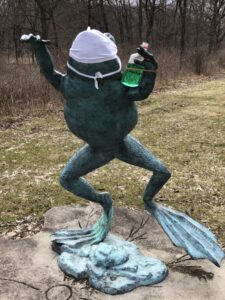
-
Masks and hand sanitizers did their jobs to help reduce the spread of SARS-CoV-2
-
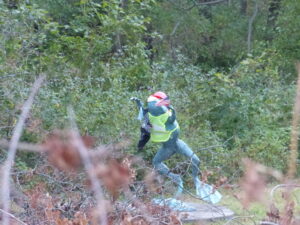
-
Cleaning up after the 2020 Derecho.
Further into the year:
-

-
A green pot of gold.
-

-
Hoppy Easter!
-
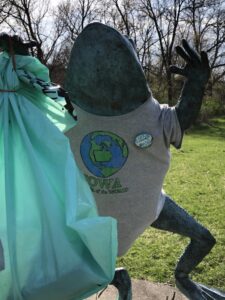
-
Keeping it Clean
Middle of the Year is graduation, summer fun, and the Fourth of July with a loyal “Vandal” from Idaho!
-
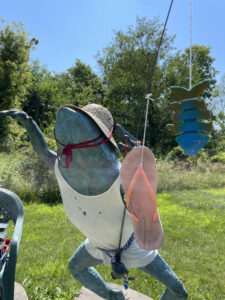
-
Summertime and the livin’ is easy.
-

-
Frog And Vandal (UIdaho) posing.
-
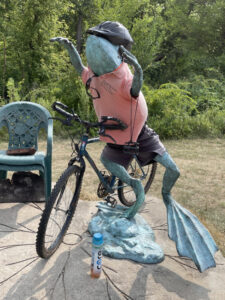
-
Amphibian Safety Patrol…
-
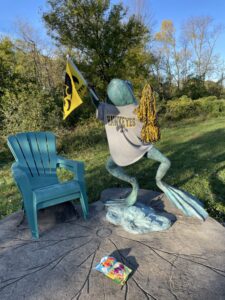
-
Go Hawks!
-
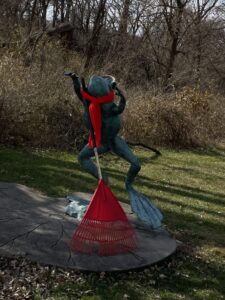
-
Does this frog practice Reiki?
-
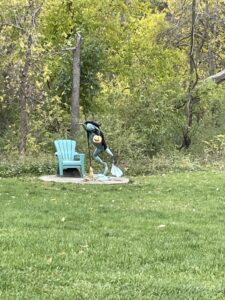
-
Coming for the candy.
Always a civic Duty Calls.
-

-
Research first.
We are “hopping” to add more photos as we walk by the ever-current and exciting Frog Statue. To learn about real frogs of Iowa visit the website link.
by Winding Pathways | Apr 20, 2023 | (Sub)Urban Homesteading, Garden/Yard, Garden/Yard
People make a “to-do” about moles. They might be the most disliked animal in suburbia. We have them at Winding Pathways and are sharing tips on what we do about them.
Human Created Problems
Suburban and urban soil has a common problem. It is too often compacted. Construction companies often scrape topsoil off a yard before building a house. Then, they drive vehicles in the yard. When a family moves in, they soon create a dog run, drive their cars on the grass, and play on the lawn. Too many footsteps by pooches or people compact the ground.
Nature Has Solutions
Lawn plants struggle to thrive in tight soil, but nature has a remedy. Fossorial animals live in the soil and include moles, gophers, shrews, ants, worms, and others. Their burrowing constantly mixes and softens the dirt they live in, making it easier for plants to live.
Moles or Gophers?
People often confuse moles with gophers, but it’s easy to tell them apart. Moles prefer living in moist shady places and are at home in suburbia. They eat grubs and worms. Gophers, in contrast, are more likely to live in rural sunny pastures with dry soil and mostly eat roots. Mole hills are symmetrical, like mini volcano cones. Gophers, in contrast, make elliptical hills.
What Do You Really Value?
Ironically, most people who trap or poison moles profess to love a rich, green, “healthy” lawn, ignoring that nature loves diversity, not monocultures. Moles help make healthy lawns happen. Granted their hills of dirt and heaped linear tunnels can be unsightly and catch lawn mower blades.
Here is what we do at Winding Pathways:
- Thank our moles for helping make the soil soft and fertile.
- Rake out their hills before mowing.
- Stomp down their raised tunnels so our lawn mower does not catch on them.
- Enjoy the diversity of life in our yard.
Moles are as fascinating and beneficial as the butterflies that pollinate blooms or the cardinals who pluck seeds from feeders. They deserve respect for their valuable work.
-
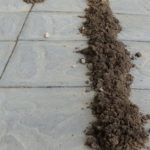
-
Moles bring rich dirt from below to the surface as they tunnel along hunting for earthworms and grubs.
-
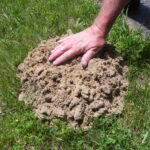
-
Moles sometimes push up excess dirt.
-
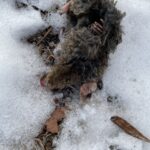
-
Moles’ feet are made for clearing dirt away.
by Winding Pathways | Nov 24, 2022 | (Sub)Urban Homesteading, Birds, Bugs, Flowers/Grasses, Foraging, Garden/Yard, Nature
We think of fall as migration time when all the birds leave. And there is a great birdcast website to see in live time the flights. But an autumn walk through a park with wild edges reveals shrubs, bushes, and grasses alive with bird activity. Visit an orchard on a cold winter day and the odds are good for spotting robins pecking on frozen dropped apples, but wild fruits are more common, all just beyond suburbia.
Let’s step back to spring. When Rich worked at the Indian Creek Nature Center his phone would often ring during those first warm days. With excitement callers would announce that the robins had returned. Spring’s here!
Seeing a robin on a spring lawn gives the illusion that they’ve just made a long journey from a faraway wintering ground down south. Robins, bluebirds, and other birds usually just shift where they live and forage as seasons change.
Ecological Survivors
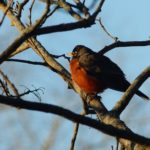
A robin surveys the area
Robins, in particular, are ecological survivors. They’re adapted to living on lawns and around people during the warm months, where they nest on porch eaves and forage for worms and bugs in mowed grass. The coming of fall’s cold marks the disappearance of robins from suburbia. They don’t go far and make an amazing dietary switcheroo to wild fruits.
Robins and bluebirds shun their summer buggy and wormy diet and shift to fruits and some seeds come winter.
On an October walk, we spotted several wild fruits – berries perhaps – that birds feast on during the cold months. the native plants are great – even the poison ivy – the exotics are problematic.
Here are some common winter weedy and seedy plants:
- Gray Dogwood. This small native dogwood often forms thickets along trails, parks, woods, and even yards and holds plenty of berries into cold months.
- Wild grapes. People rarely eat sour and seedy wild grapes, and sometimes birds also leave them alone during summer, but come winter the raison-like grapes make nutritious avian fare.
- Poke Weed. In late fall this tall purple-stemmed and fruited plant is hard to miss. Birds eat the frozen berries. Note: Poke berries are toxic to people and many mammals but not birds.
- Poison ivy. Gulp. This bane of allergic people is a beneficial wildlife plant. Deer and rabbits browse on the woody sprouts and birds feast on the berries.
- Asian Honeysuckle, Japanese Barberry, and Oriental bittersweet are “dirty bird plants.” Actually, birds love the berries and carry them far and wide to poop out the seeds. All three exotic plants are highly invasive and crowd out more desirable native plants. Birds have helped them conquer woodlands and field edges to the detriment of healthy bio-diversity.
-
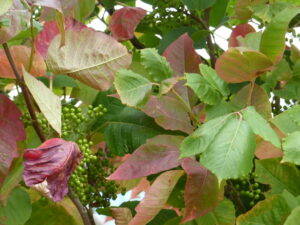
-
Poison Ivy berries are a favorite of birds.
-
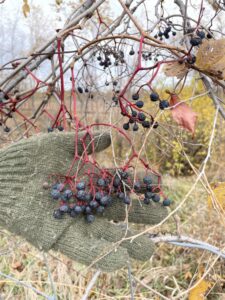
-
Wild grapes are a tasty winter treat.
-
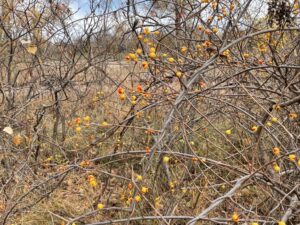
-
An invasive species and favorite of birds.
Winter Fare Is More Than Fruits
Winter bird fare isn’t just fruit. Many birds glean frozen spiders and insects from crevices in tree bark and dozens of species continue to eat grass and “weed” seeds. That’s a problem with mowed lawns. They produce no seeds, so few birds visit them during the colder months. Taller growing grasses, flowers, and shrubs often hold their seeds into the winter and are bird magnets.
-
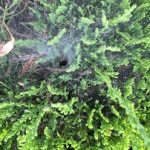
-
This beneficial spider controls insects in the yard.
-
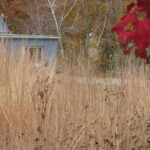
-
Birds bob on prairie grasses.
-
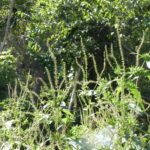
-
Ragweed seeds last through the winter.
Want to have birds in the yard all winter? Keeping feeders stocked helps, but better results come when homeowners encourage buffers of native shrubs, vines, and grasses that produce natural winter bird food and habitat. Most people love their tidy lawn, but edging the lawn, usually along a property line, or creating “pocket prairies” with native or desirable tall grasses, wildflowers, and shrubs adds summer color and year-round wildlife appeal. So, we encourage readers to create and leave wilder spaces for the birds!
by Winding Pathways | Nov 17, 2022 | (Sub)Urban Homesteading, Flowers/Grasses, Garden/Yard, Garden/Yard
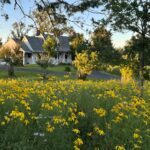
Prairie flowers dance on a knoll.
Motorists passing our yard must think we have a messy yard. Instead of the clipped and sprayed yards of neighbors, ours is a dancing field of tall wildflowers and native grasses. Many consider them “weeds”. Our yard is unconventional, healthy, and beautiful. It attracts desirable wildlife and is dynamic. Visitors, especially children, love walking through six-foot-tall grasses on our labyrinth pathway. To us, pollinators and birds, it’s heaven, not a mess. It is a naturally landscaped yard.
Sugar Grove Farm Paves the Way
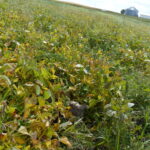
The space between crops is productive in a different way.
Last summer Rich toured Rodale Institute’s plantings at Sugar Grove Farm near Cedar Rapids. Researcher Linda Sturm led him and farmers to plots of vegetables and fields of corn and soybeans before stopping by a long row of what looked like weeds with wildflowers mixed in.
“This is an unproductive area, wasted ground, that could have been planted to corn,” a farmer remarked. Linda countered that it is likely the most productive land on the farm. “It’s the home base for pollinators and birds. They forage in nearby crops to collect nectar and eat insect pests,” she said.
Natural Yards Can Reduce Pests
Same thing at Winding Pathways. Our vegetable garden is amazingly productive despite never using insecticides and only mowing sparingly. Butterflies visit squash, cucumbers, okra and other crops, spreading pollen while wrens constantly forage for insects to feed their hungry young.
A clipped and sprayed lawn is only slightly more attractive to wildlife than pavement. There’s no place for tiny beneficial creatures to live.
-
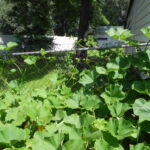
-
Birds and insects forage in the garden.
-

-
This yard offers little to wildlife.
Create Pollinator Patches
Homeowners with small yards can help pollinators and birds by creating islands or strips of welcoming habitat, perhaps in the backyard or along the property line. Linda Strum created habitats within farm fields, and suburban homeowners can enjoy the same benefits. Worry about the neighbor’s reaction? Just create a habitat in the backyard out of sight of passersby.
-

-
Native and cultivated plants brighten a front yard.
-
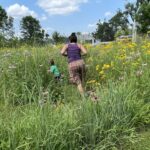
-
Adults and children revel in the natural yard.
-
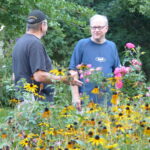
-
Converting a yard to more natural plants brings joy.
Adding birdhouses adds to wildlife fun. We love watching house wrens hunt insects and bring their catch to their babies nestled in a wooden birdhouse dangling down from our porch ceiling.
Given a bit of imagination and fun work even the smallest yard can appear tidy, be aesthetically diverse, and provide homes for butterflies and wondrous spaces for kids and adults.

































